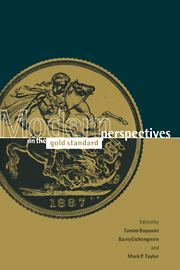Book contents
- Frontmatter
- Contents
- List of figures
- List of tables
- Notes on the contributors
- I Introduction
- II Operation of the gold standard
- III Adjustment mechanisms
- IV Monetary issues
- V Exchange rate behavior
- 11 The dollar/pound real exchange rate and fiscal policy during the gold standard period
- 12 Exchange rate dynamics and monetary reforms: theory and evidence from Britain's return to gold
- VI Conclusions
- Index
12 - Exchange rate dynamics and monetary reforms: theory and evidence from Britain's return to gold
Published online by Cambridge University Press: 05 November 2011
- Frontmatter
- Contents
- List of figures
- List of tables
- Notes on the contributors
- I Introduction
- II Operation of the gold standard
- III Adjustment mechanisms
- IV Monetary issues
- V Exchange rate behavior
- 11 The dollar/pound real exchange rate and fiscal policy during the gold standard period
- 12 Exchange rate dynamics and monetary reforms: theory and evidence from Britain's return to gold
- VI Conclusions
- Index
Summary
Introduction
The appreciation of sterling prior to the return to gold in April 1925 was thought by economists of the period to be a consequence of the anticipation of the return to gold rather than an improvement in fundamentals. For instance, in a well known quotation, Keynes in “The Economic Consequences of Mr. Churchill” wrote:
The movement away from equilibrium began in October last [1924] and has proceeded step by step with the improvement of the exchange brought about first by the anticipation, and then by the fact, of the restoration of gold, and not by an improvement in the intrinsic value of sterling.
(Keynes, 1972, 209–210)The pioneering contributions of Sargent (1986) and Flood and Garber (1983) have initiated a rich literature on credibility, monetary reform, and issues of exchange rate dynamics under alternative regimes. More recent extensions by Froot and Obstfeld (1991) and Smith (1989) now offer closed form solutions that allow for economic interpretations, as reflected in a growing literature on the application of the theory of stochastic process switching to the analysis of actual economic events and issues.
The example of Britain's return to gold in the Flood and Garber paper has been further considered by Miller and Sutherland (1994), Smith and Smith (1990), and Krugman and Rotemberg (1992).
Information
- Type
- Chapter
- Information
- Modern Perspectives on the Gold Standard , pp. 341 - 362Publisher: Cambridge University PressPrint publication year: 1997
